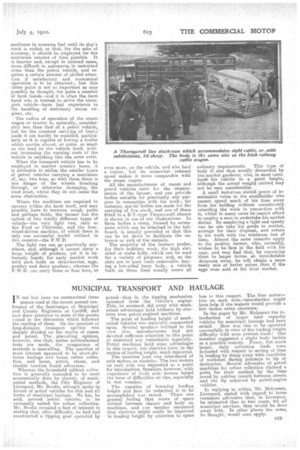MUNICIPAL TRANSPORT AND HAULAGE
Page 15

If you've noticed an error in this article please click here to report it so we can fix it.
IN our last issue we summarized three papers read at the recent. annual conference of the Institutipn of Municipal and County Engineers at Cardiff, and now draw attention to some of the points raised in the discussion which followed the reading of them. On the question of long-distance transport opinion was sharply divided on the merits of steam and petrol. The , prevailing opinion, however, was that, unless particularized tests are made,the comparison of methods is unavailing. The question of most interest appeared to be short-distance haulage and house refuse collection, and horse, petrol, steam, and electric traction found advocates.
Whereas the household rubbish collection is generally conceded to be most economically done by electric, of mechanical methods, the City Engineer of Liverpool, Mr. Brodie. strongly spoke in favour of petrol vehicles for this and all forms of municipal haulage. He has, he said, proved petrel vehicles to be eminently suited for refuse collection. Mr. Brodie revealed a fact of interest in stating that, after difficulty, he had had constructed a tipping gear operated by
petrol—that is, the tipping mechanism operated from the vehicle's engine. This, he assumed, did away with mechanical advantages held hitherto byelectries over petrol-engined machines, The point of loading height of mechenical vehicles was especially commented upon. Several speakers inclined to the view that manufacturers . had notdevoted sufficient attention to this point or exercised any remarkable ingenuity. Petrol machines hold some advantages in this respect, but. electrics have, in the matter of loading height, much improved. The question here was introduced of axle motors on electric:. The two motors on each axle was suggested as a point for introduction. Speakers, however, with experience of frent axle motors raised the issue of difficulties on tips, especially in wet weather.
The question of lowering loading height. and how its reduction is to be
accomplished was raised. There was general feeling that waste of space existed between chassis and body on machines, and tem speaker suggested that electrics might easily be improved in loading height by attention to space loss in this respect. The four motor— two on each axle—introduction might here help if the makers would provide a few inches extra clearance.
In. the paper by Mr. Melyneux the introduction of larger load capacity vehicles for municipal haulage bad been raised. How was this to be operated successfully in view of the loading height difficulty with even present loads'?One member suggested a slight body incline as a possible remedy. Fewer, but much larger, daily collection loads were favoured with respect to saving of time in loading by doing away with inactivity of workmen during journeys to tip or destructor. Several advocates of petrol machines for refuse collection claimed a point for their method by the time saved by quicker transit between streets and the tip achieved by petrol-engine vehicles.
In replying to critics,' Mr. Molyneux, Liverpool, stated with regard to horse transport advocates that, in Liverpool, he estimated that in two years, for all ,municipal services, they would be done away with. In other places the same, he thogght, would soon apply.








































